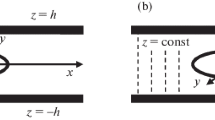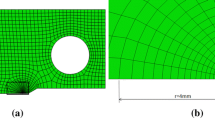Abstract
Assumptions underlying the surface strain measurements of Part I are outlined. The criterion of Luders' band formation was maximum shear stress. It was found possible to calculate the load for loss of constraint in the various thicknesses from a complete elastic solution. Further observations, including those on crack angle, appear to reflect a dominant role played by the general level of the elastic-strain field during constrained flow. It is shown from strain measurements that a full oblique fracture can be compatible with ductilities that vary by almost an order of magnitude. The ductility associated with oblique or inclined fracture seems to be that developed by the material during plane strain flow under a plane stress.
Résumé
Les hypothèses sous-jacentes aux mesures des déformations en surface effectuées dans la première partie du mémoire sont soulignées. Le critère de formation des bandes de Lüders était le cisaillement maximum. On a estimé possible de calculer la charge correspondant à la suppression de la rétention élastique pour diverses épaisseurs, dans le cas d'une solution complètement élastique. Des observations complémentaires, notamment de l'angle de la fissure, laissent apparaître le rôle déterminant que joue le niveau général du champ de déformation élastique au cours d'un écoulement plastique. On montre également, à partir de mesures de déformations, qu'une rupture complètement oblique peut être compatible avec des ductilités variant de près d'un ordre de grandeur. Dès lors, l'aspect de la rupture n'a qu'une utilisé limitée. Enfin, il apparaît que la ductilité associée à une rupture oblique ou inclinée résulte d'un écoulement plastique en état plan de déformation dans le matériau sollicité en état plan de tension.
Zusammenfassung
Die Annahmen die der Oberflächenverformungsmessungen des ersten Teils zugrunde liegen werden hervorgehoben. Das Kriterium für die Bildung von Lüderslinien war die maximale Querspannung. Ausgehend von einer ganz elastischen Lösung fand man die Möglichkeit die Last zu rechnen, die zur Aufhebung der Zwengungen für die verschiedenene Dicken führt. Weitere Beobachtungen, einschließlich die des Rißwinkels zeigen, daß eine hervorragende Rolle von der allgemeinen Lage des elastischen Verformungsfeldes während des Zwengungsfließens Verformungsmessungen zeigen daß ein ganz schiefer Bruch mit Dehnbarkeiten die fast um eine Größenordnung ändern, vereinbar sind. Die einem schiefen oder geneigten Bruch zugehörige Dehnbarkeit scheint die Dehnbarkeit des Materials zu sein während des ebenen plastischen Fließens im ebenen Spannungszustand.
Similar content being viewed by others
References
L. P. Trudeau, Shear Lips, Zero Isoclinics, and Fracture, Mines Branch Research Report R201, Department of Energy, Mines and Resources, Ottawa, Canada (January 1969).
L. P. Trudeau, Interrelationship of Deformation and Fracture Contours, Mines Branch Research Report R220, Department of Energy, Mines and Resources, Ottawa, Canada (January 1970).
T. A. Cruse, Lateral Constraint in a Cracked, Three-Dimensional Elastic Body, Int. J. of Fracture Mech., 6 (1970) 326–328.
J. R. Dixon, Computed Values of the Elastic Stresses Around a Crack in an Infinite Plate Under Tension, NEL ReportNo. 12, East Kilbride, Glasgow, National Engineering Laboratory (1961).
W. F. Brown Jr. and J. E. Srawley, Plane Strain Crack Toughness Testing of High-Strength Metallic Materials, ASTM Spec. Tech. Pub. No. 410 (1969).
J. R. Dixon, J. S. Strannigan and J. McGregor, Stress Distribution in a Single-Edge-Notch Tension Specimen, NEL ReportNo. 357, East Kilbridge, Glasgow, National Engineering Laboratory (1968).
L. P. Pook, The Effect of Friction on Pin Jointed Single Edge Notch Fracture Toughness Test Specimens, Int. J. of Fracture Mech., 4 (1968) 295–297.
R. C. Bates and W. G. ClarkJr., Fractography and Fracture Mechanics, ASM Transactions, 62, 2 (1969) 380–389.
D. P. Clausing, Effect of Plastic Strain State on Ductility and Toughness, Int. J. of Fracture Mech., 6 (1970) 71–85.
Author information
Authors and Affiliations
Rights and permissions
About this article
Cite this article
Trudeau, L.P., Vosikovsky, O. Strain fields of cracks under tension including thickness effects. Int J Fract 10, 159–166 (1974). https://doi.org/10.1007/BF00113923
Received:
Issue Date:
DOI: https://doi.org/10.1007/BF00113923




